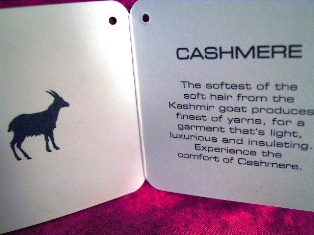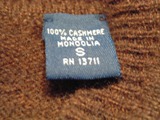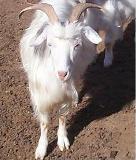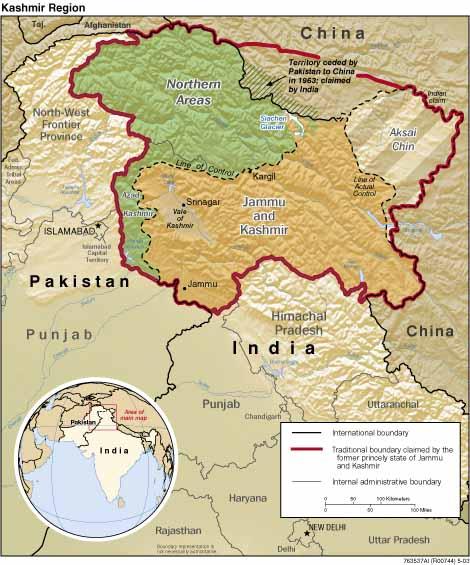 |
TED Case Studies: Number 786 May, 2005 Cashmere as Geographical Indications Koji Yamamoto |
This site examines the possibility of claiming Geographical Indications of cashmere produced in Kashmir. Based on the fact that the cashmere made in Kashmir has its own quality, culture, history, and tradition, all of which are unique and original there, I argue that Kashmir deserves to claim Geographical Indications.
2. Description
In this project, I will discuss the following three main issues:
(i) intellectual property rights issues regarding Geographical Indications discussed in the current Doha Round under the WTO, which could have the impacts, future, and possibility of Geographical Indications of cashmere produced in Kashmir;
(ii) the characteristics of the cashmere wool and goats in Kashmir, which includes the history of the Kashmir region, as well as culture, traditions, and society of the people living in Kashmir, and the necessities of making pashmina, which is the cashmere whose quality is the best in Kashmir; and
(iii) the characteristics of the cashmere trade, including major exporters and importers in the world cashmere market.
Under the Trade-Related Aspects of International Property Rights (TRIPS), the Geographical Indications are defined as “place names (in some countries also words associated with a place) used to identify the origin and quality, reputation or other characteristics of products.”
Article 22 is applied to all products, which defines a standard level of protection. This article says geographical indications must be protected to avoid misleading the public and to prevent unfair competition.
On the other hand, Article 23 provides a higher level of protection for geographical indications for only wines and spirits, a number of countries want to extend this level of protection to a wide range of other products. As a result, in the Doha Round, possible extension of the higher level of protection beyond wines and spirits has been discussed.
Currently, two issues have been debated in since the Doha round began in November 2001:
(i) creating a multilateral register for wines and spirits; and
(ii) extending the higher (Article 23) level of protection beyond wines and spirits.
The Doha round is very important because it could result in the expansion of Geographical Indications to more goods and services in which cashmere could be included.
 |
Cashmere is the luxuriously soft and extremely warm wool of the cashmere goats whose origin is the Kashmir Valley. Cashmere goats can be characterized as follows: “A cashmere goat is one which produces a fine undercoat of any commercially acceptable color and length. This down should be less than 19 micrometers (µm) in diameter.” Among others, there is the so-called “pashmina,” which is considered the Kashmir's best cashmere.
2-3 Cashmere in Kashmir-Pashmina[1]
In Kashmir, cashmere goats (Kashmir goats or Himalayan mountain goats) are a member of Capra hircus. Also, the fine wool we commonly call cashmere have been called “pashm,” which is the Persian word for “wool.” Pashmina is pashm in its woven form, the highest quality of cashmere, and cashmere goats in Kashmir are often referred to as the “pashmina goat.”
The pashmina goats which live above 4500 meters (14,500') produce the finest wool. The growth of the fine and warm pashm is natural for people living there to adapt the harshly windy location. There, winter temperatures that fall as low as minus 30 degrees Celsius (-22° F).
Pashm has a special characteristic due to its long and fine fibers, which are as thin as “12 microns.” By contrast, the fibers from premium sheep's wool, such as Merino Extrafine, are “23 microns” thick, and human hair ranges up to “200 microns” thickness. Thus, because of this thinness, pashmina is exceptionally light, soft and warm, and feels luxurious. The natural colors of the pashmina range from white to gray, red, brown and black.
 |
The very best pashm comes from one remote area in western Tibet known as the Changtang, where nomadic pastoralists known as Drokba tend flocks on the high plains. They collect the fleece by combing the goats in the late spring, just before they molt. Each goat produces approximately 100 grams (3 1/2 oz) of uncleaned fleece, which is a mix of pashm and coarser hairs.
In summer, Ladakhi traders come to the Changtang to exchange the raw fleece for grain, tea and manufactured goods. They transport the fleece to Leh, the capital of Ladakh, where the Kashmir dealers make their purchases and then forward the wool to Srinigar.
Muhamad Yusuf Khan is a “pashm” dealer in Srinigar. Muhamad Yusuf Khan's family has been in the business for more than 150 years. When Muhamad's family first started dealing in pashm, they used animal caravans to bring the fleece over the mountain passes from Leh, but today it comes in by air.
 |
Muhamad thinks that his success was really just a combination of honesty, hard work and luck. In order to become a successful dealer, “You must be a reputable dealer,” he said, “because the shawl trade is based on trust. From raw fiber to finished shawl, we must guard our reputation by controlling all aspects of production.” However, when he was asked by Hansen about the special purpose of the shawl, Muhamad replied. “Well, just between you and me, I wear a shawl because it keeps me warm in the winter. It is beautiful, but it is really just the Kashmir jacket.”
3. Related Cases
3-1 Cashmere
(1) Cashmere by Theresa Purcell (May, 1996)
This case study focuses on the cashmere trade battle between China and Scotland. As Chinese textile and apparel exports, other countries increasingly experienced difficult to competing with China. Scotland is one of the countries whose traditional cashmere industries had been challenged by China
 |
4. Author and Date
Koji Yamamoto, May 4, 2005
6. Forum and Scope: WTO and Multilateral
7. Decision Breadth: Kashmir and countries producing cashmere products
8. Legal Standing: Treaty
9. Geographic Location:
 |
a. Geographic Domain: Asia
b. Geographic Site: South Asia
c. Geographic Impact: Kashmir (China, India, and Pakistan)
10. Sub-National Factors: Yes
11. Type of Habitat: Cool
12. Type of Measure: Intellectual Property
13. Direct v. Indirect Impacts: Direct
14. Relation of Trade Measure to Environmental Impact
a. Directly Related to Product: Yes, Cashmere
b. Indirectly Related to Product: No
c. Not Related to Product: Yes
d. Related to Process: Yes, Intellectual Property
15. Trade Product Identification: Cashmere
16. Economic Data: World Production (14,000-15,000 ton)
17. Impact of Trade Restriction: Low
18. Industry Sector: Textiles and Clothing
| Exporters |
Importers |
| China (10,000 tons annually) |
The United States |
| Mongolia (3,000 tons annually) |
EU (Britain, Belgium,
France, German, Italy) |
| Iran (1,800 tons in 1991) |
Japan |
| Afghanistan (1,800 tons
in 1991) |
Australia |
| Pakistan (600 tons in
1991) |
Korea |
| New Zealand (150 tons
in 1991) |
|
| Australia (65 tons in
1991) |
|
| Turkey |
|
| Iraq |
|
| The United States |
|
| Kashmir |
Cashmere Trade
 |
China is the biggest supplier of cashmere in the world. During the 1990s, it produced approximately 8,000 tons of cashmere annually. According to the latest statistics, in 2002, China supplied about 10,000 tons of cashmere and this amount is equivalent to more than two thirds of the world production of it. In fact, with cheap but diligent labor force, the Chinese textile and apparel industry is the largest producer in world. The industry accounts for more than 25% of all the Chinese exports and produces over $40 billion annually.
 |
Mongolia is the second largest producer of cashmere. The Mongolia's share in the world cashmere production accounts for more than 20%, or 3,000 tons. Cashmere is the third biggest exporting sector in Mongolia, after copper and gold, and the cashmere industry is the largest employer in the economy.
In short, China and Mongolia account for more than four fifths of the entire cashmere production in the world. However, there are other countries producing cashmere. For example, Iran and Afghanistan produce 1800 tons; Pakistan - 600 tons; New Zealand - 150 tons; Australia - 65 tons in 1991.
Moreover, according to the Department of Animal Science at Oklahoma State University, along with the countries above, there are also cashmere goats in Turkey. Furthermore, imported from Australia and New Zealand in the late 1980's, there are some cashmere goats in the United States, too.
Meanwhile, the United States, the European Union, and Japan are the largest customers of cashmere products. Because cashmere is a luxury commodity, importing countries tend to be developed countries. Hence, the demand of cashmere heavily relies on the situations of these economies.
20. Environmental Problem Type: Culture
21. Name, Type, and Diversity of Species
Name: Cashmere Goat, a member of the species "Capra hircus"
Type: Goat (All goats are Capra hircus)
Diversity: Cashmere goats are from Kashmir.
22. Resource Impact and Effect: Low and Product23. Urgency and Lifetime: Low and about 15 years
24. Substitutes: Like Wool Products
25. Culture: Yes
26. Trans-Boundary Issues: Yes, Kashmir is under dispute.
Kashmir, which includes the regions of Jammu, Kashmir, and Ladkh politically, is currently divided into three countries: Pakistan controls the northwest parts, India has the central and southern portion, and China claims the northeastern region.
Historically, according to Subbiah, the Security Council of the United Nations has failed to bring about a permanent resolution for this dispute. The Security Council has been silent since 1965 and the issue has been discussed bilaterally between India and Pakistan since then. On the other hand, Kashmir began to move towards its independence in the late 1980s.
Most recently, a bus route which connected Muzaffarabad, capital of the Pakistani-governed Kashmir, and Strinagar, capital of the Indian-governed Kashmir was announced in February 2005.
The conflict between India and Pakistan over Kashmir is one of the most difficult sovereignty disputes in the world. Because of this situation, it could be difficult for a country instead of Kashmir and people living in Kashmir to claim their Geographical Indications over their cashmere products.
27. Human Rights: No
28. Relevant Literature
[1] A professor of sociology and global & international studies at the University of California, Santa Barbara. Will China dominate the textile market? Retrieved on March 1, 2005, from http://fecolumnists.expressindia.com/full_column.php?content_id=77003.
[2] BBC News (December 16, 2004) “Millions 'to lose textile jobs.'” Retrieved on March 1, 2005, from http://news.bbc.co.uk/2/hi/business/4100249.stm.
[3] The Breeds of Livestock, the Department of Animal Science at Oklahoma State University. Retrieved on March 1, 2005, from http://www.ansi.okstate.edu/breeds/goats/cashmere.
[4] Capricorn Consults!! Introduction to Cashmere. Retrieved on March 1, 2005, from http://www.capcas.com/World_Markets.html.
[5] Cashmere and Camel Hair Manufacturers Institute. Retrieved on March 1, 2005, from http://www.cashmere.org/english/index.htm.
[6] Geographic Indications Background and Current Situations in the WTO. Retrieved on March 20, 2005, from http://www.wto.org/english/tratop_e/trips_e/gi_background_e.htm.
[7] Gopinath, R., Anmed, R., Kumar, A., & Mookerjee, A. (2003).
Beyond the ban: A census of Shahtoosh workers in Jammu &
Kashmir. Retrieved on January 23, 2005, from
http://www.wildlifetrustofindia.org/shahtoosh/download/beyond_the_ban.pdf.
[8] Hansen, E (2002). "Pashmina: Kashmir's best cashmere." Saudi
Armco World (July/August). Retrieved on January 23, 2005, from
http://www.saudiaramcoworld.com/issue/200204/pashmina-kashmir.s.best.cashmere.htm.
[9] Reed, A. (February 7, 2005). Cashmere in battle to retain its world lead. Retrieved on March 1, 2005, from http://thescotsman.scotsman.com/business.cfm?id=142072005.
[10] Subbiah, S. (2004). “Security Council Mediation and the Kashmir Dispute: Reflections on its Failures and Possibilities for Renewal.” Boston College International & Comparative Law Review 27-1. Retrieved on March 20, 2005, from
http://www.bc.edu/schools/law/lawreviews/meta-elements/journals/bciclr/27_1/07_TXT.htm.
[11] Worldlife Trust of India/International Fund for Animal Welfare.
(2001). Wrap up the trade: An international campaign to save the
endangered antelope. Retrieved on January 23, 2005, from
http://www.wildlifetrustofindia.org/shahtoosh/download/shahtoosh_full.pdf.
[12] World Bank Lunchtime Seminars. (March 11 2003). Impact of Institutional and Trade Policy Reforms: Analysis of Mongolia's Cashmere Sector. Retrieve on March 1, 2005, from http://poverty.worldbank.org/files/14794_Mon_Csm_Mixed_Rep_Mar03_BBL.pdf.
[13] WTO's TRIPS website retrieved on January 23, 2005 from http://www.wto.org/english/tratop_e/trips_e/gi_e.htm. To see the language on Geographical Indications in the Doha Declaration, go to the website at http://www.wto.org/english/tratop_e/dda_e/dohaexplained_e.htm#trips.
Footnotes
[1] This section is written based on the information from Hansen (2002).
Pictures and images
[3] Taken by Mr. Shinji Kimura from the Japan Wool Products Inspection Institute Foundation
[5] Taken by Mr. Shinji Kimura from the Japan Wool Products Inspection Institute Foundation
[7] CIA: http://www.cia.gov/cia/publications/mapspub/maps/Kashmir_region2004.htm
[8] Taken by Mr. Shinji Kimura from the Japan Wool Products Inspection Institute Foundation.
[10] CIA: http://www.cia.gov/cia/publications/mapspub/maps/Kashmir_region.htm
© Koji Yamamoto 2005

